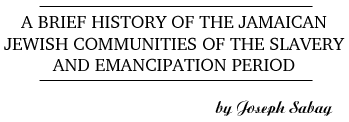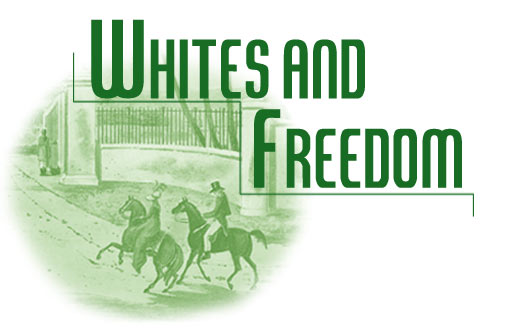
The story
of the Jewish diaspora has been one of relentless
endurance. Throughout the past two millennia, millions of Jews were killed in
the names of foreign G-ds. Religious, political, and
economic pressures forced them to travel the world in search of freedom. No
corner of the earth remains unseen by Semitic eyes. The history of the Jewish
Jamaicans begins well before the periods of western exploration and colonial
imperialism, although many of their struggles are rooted in the 14th
and 15th century, during the mighty trials of the Iberian
inquisitions.
Throughout
the 1400's the Inquistion attempted to raze
the Jewish populations of Spain and Portugal. They were forced underground; Great
riots broke out, and mobs killed thousands in the Spanish riots of
1391 and 1392. Many gave way to the dominant Catholic Church, and
participated in large public baptisms where they were forced to renounce
their faith. These converts became known as “Conversos”.
In time, the Catholic-dominated societies became displeased with the
ambiguous Conversos, many of whom continued to practice as Jews in the
privacy of their homes. As Anti-Semitic feelings reached their climax
in the late 15th century, the Conversos
soon became the “Marranos” meaning swine.
The office of the Inquisition had once again been resurrected in 1480,
again placing the Jews in a constant light of suspicion. By August
of 1492 millions of Jews would suffer the racial cleansing practiced
by the angry rulers of Spain. King Ferdinand and Queen Isabella
ordered the Jews to convert or face expulsion; many were burned alive.
Many others fled by way of Portugal to more hospitable lands in both
the Old
World and the New.
Jamaica was first reached by Christopher
Columbus, a man of ambiguous origins.
Some claim he was Italian, some, a Basque, and others assert
that he was a Marrano Jew. Columbus had contracted the right to governorship
of all lands he claimed for Spain in the New World, and the laws of the Inquisition
were not included in his territories. Unfortunately disputes with
the crown arose, challenging the terms of his proprietorship; restrictions
were also created to help the Spanish and Portuguese control the migration
of the Jews to the west. Jamaica was eventually acquired by Columbus’s son, and then subsequently passed
on to his granddaughter who would marry into the house of Braganza and unify the island with the rest of the Portuguese
colonies. This brought about the first migration of Jewish Sephardim
to the island, coming from Portugal around 1530.
[1]
Jamaica passed into the hands of the Spanish
when the Iberian crowns were unified, but in 1655 the English gained
control of the island. A Marrano named Acosta
was the chief negotiator in the surrender.
[2]
Jamaica had always been more of a strategic
location rather than an economic prospect in the eyes of the Spanish.
The British had already learned how lucrative the plantations could
be, through their trials in earlier colonies. Oliver Cromwell received
Simon de Caceres, an openly practicing Jew, as his West Indian advisor.
[3]
De Caceres had earlier been in exile in Amsterdam, awaiting the changes that the British
Civil War would bring about. In late 1660 the Sephardim petitioned
for the right to remain in Jamaica, and the British permitted them willingly,
thinking of them as good for establishing business and trade. The
presence and tolerance of the colonial British government brought
Jamaica’s first wave of Ashkenazi Jews from
England and Germany in 1663, along with more Portuguese
Sephardim from the recently fallen Dutch colonies.
[4]
By 1665 the Jews were greatly involved in commerce,
and had nearly monopolized the vanilla industry. The success of the
industrious Sephardic community created
a disturbance among the wealthy, white elite of Jamaica. The Jews would then face a period
of economic oppression that would last until 1826.
By
the turn of the 18th century, sources indicate that there
were nearly 80 heads of Jewish households, among a population of 7,000
whites.
[5]
The Sephardim had openly established cemeteries
and synagogues in the Port Royal area upon the British arrival, and
by this time the different customs had combined into a new “Jewmaican”
culture. The big businessmen of the Island began their campaign against the Jews by trying to
pass a “wholesale only” restriction upon Jewish commerce, thus restricting
them from participating in retail transactions. By 1700 the Jewish
population bore an amazing tax load. Still, through their persistence,
Jews flourished as shopkeepers, traders, mariners, and slave traders.
Research of property records show that few Jews actually had plantations.
[6]
The Jews had a stake in the slave auctioning system,
because it was trade oriented in nature. They managed to gain considerable
control of the import industries through networking with other Marrano
and Sephardic Jews in the Carribean;
consequently, they all lived in Port Royal on the southern side of the island where heavy trade and
commerce flourished. The great earthquake of 1692 sent the Sephardim
to next-door Kingston after their synagogue was destroyed.
The
Sephardim formed the congregation of Kol
Kadosh Shahar Hashamayim
in 1693, and managed to purchase large areas of property in Kingston’s newly forming commercial district.
In 1744 the Spanish and Portuguese Jewish community would consecrate
a two-story synagogue which embodied the new Jewmaican
culture that had arisen. They decorated it with colorful eastern style
rugs, Jamaican woodwork and six large silver candelabra. They also
practiced a Sephardic custom of strewing sand all over the floor in remembrance
of the Tabernacle. By 1730, Jews composed nearly 20 percent of Kingston’s white population.
[7]
The Ashkenazi community later created their own
congregation in 1789.
Through
out the 18th century, Jews were disproportionately taxed,
were not allowed to participate in government, and did not enjoy the
rights of legal citizens. The
heavy disabilities were accompanied by suspicion. Many accused Jews
of transacting with the Maroons, and it was also rumored that they
bought stolen goods from the slaves in exchange for certain contraband
items. At the turn of the 19th century the sugar market
in Jamaica became destabilized, and the Haitian
revolution had spread public fear of slave revolt. The Jamaican government
found that it was in their best interest to propagate a relationship
with the Jewish community. The early 1800’s brought about more recognition
and religious freedom for the Sephardim of Kingston. In 1826, after
several civil rights related cases, the discriminatory taxes were
lifted, followed by full citizen rights in 1831, 27 years before the
English. The Jamaican parliament presented a silver tankard to Moses
Delgado, in a public display of acceptance. Delgado was an intelligent
businessman, a leader in the Sephardic community,
and a generous friend of the governorship.
[8]
The Jews quickly involved themselves in the Jamaican
government. By 1849 they held 8 of 49 seats in the Parliament.
The
Sephardim were also quick to establish welfare foundations during
the immediate post-emancipation era. The Hebrew National Institution
was founded in 1847 followed by the Hebrew Benevolent Institution
in 1851. Their mission was to “help Jews become stimulated to self
dependence and industry.” A Hebrew Alms House was established to provide
care for those in struggle, the group even provided a small scale
industrial loan department. During this period, two men from prominent
Sephardic families, Michael DeCordova and Benjamin A. Franklin, led the Jewish community
while becoming seriously involved in the local and national government.
This was a trend of many young professional Sephardic
men.
Michael
DeCordova was one of the most important people of the emancipation
era, and at the same time a most unknown character. His family was
among the original Portugese immigrants,
and they had a long record of community involvement. DeCordova
had an extremely developed career. During his lifetime his accomplishments
included director and founding member of the Hebrew Benevolent Institution,
Secretary of the Commercial Assembly of the Kingston Chamber of Commerce,
founding member and treasurer of the Hebrew National Institution,
manager of the Jamaican news room and commercial exchange, Vestryman
at Kol Kadosh Shahar Hashamayim,
and founder of his own printing company.
Finally, he was the editor and proprietor of “The Gleaner”
(est. 1834), Jamaica’s “oldest and most widely circulated
newspaper. The paper was so
successful it was offered in both daily and semi-weekly editions,
and is still the foremost newspaper on the island. DeCordova
had presence in the economic markets through his “most extensive advertising
sheet.” Several years after the founding of “The Gleaner” another
Jew named George Levy had founded the “Colonial Standard Daily”.
[9]
This effectively gave the Jews considerable control
over the news media and printing presses.
The
Jews also made their way into public office, and expanded into over
24 cities around the island. Men
with heavily Jewish names, such as Salomon, DeCordova,
Salom, Altman, Levy, Franklin, Delgado, and Stines
became justices of the Peace. They
became clerks of the municipal boards, and active among the fire wardens. Jews also took a serious interest in the office
of petty debt collection, with Henry Salomon in office. Salomon was
also on the municipal board of commerce, the treasurer of the St. Ann’s Bay industrial board, and the son
of a respected magistrate. The
rosters of legal attorneys in the 1860's included names such as Cohen
and Levy.
[10]
It
seems that very few people could have been more involved than Benjamin
A. Franklin. He holds a remarkable record of service. His credentials
include consulate of Denmark, member of the Kingston chamber of commerce,
Kingston commissioner of roads, justice of the peace, founding member
and president of the Hebrew National Institution, founding member
and president of the Hebrew Benevolent Institution, treasurer of the
Royal Incorporation Society of Art and Agriculture, city councilman,
vestryman at Kol Kadosh Shahar Hashamayim,
and treasurer of the commercial assembly of Kingston.
[11]
With
the efforts of leaders such as DeCordova
and Franklin, the Jews of Jamaica have been able to sustain a steady
population of nearly 1700 families since the mid-19th century. After
the abolition of the constitution in 1866, the Jews took an even greater
interest in the Jamaican government, and help to steer the country
through the economic turmoil of the post-emancipation era. The Jews
helped many blacks by lending them money and credit as they became
free. Still today, the Jew or “Israelite” is viewed differently in
Jamaica than in any other part of the Carribean. The story
of the Jews of Jamaica parallels, in some ways, that of those who
came to the U.S.A. in the early 1900's in search of
freedom from the persecution of the Russians and other Europeans.
The remarkable capability to adapt and persist is what the “Jewmaicans”
represent. While the plight of the Spanish and Portugese
Sephardim seems buried under the tragedies of black slavery and emancipation,
the significance of their later involvement with Jamaican politics
and economics is still evident. The survival instincts of the Jews
truly helped them to flourish in Jamaica.
[1] Mordechai
Arbell, The Portugese
Jews of Jamaica,(Kingston, 2000,) 7.
[2] Rabbi Bernard Hooker, United
Congregation of Israelites Pamphlet (Kingston, Jamaica,) 1961; Carol Holzberg,
Minorities and Power in a Black Society, (Lanham, Maryland,) 1987.
[3] Hooker, United Congregation of
Israelites.
[4] Holzberg,
Minorities and Power, 16.
[5] Hooker, United Congregation of
Israelites; Holzberg, Minorities and Power,
20.
[6] Holzberg,
Minorities and Power,21.
[7] Holzberg,
Minorities and Power,24.
[8] Hooker, United Congregation of
Israelites.
[9] Decordova’s
Almanac and Jamaican Pocket Book; (Kingston Jamaica. 1869 and 1871
editions.)
[10] Arbell, Portuguese
Jews; Decordova’s Almanac.
[11] Decordova’s
Almanac
WORKS CITED
Arbell,
Mordechai. The Portugese
Jews of Jamaica. Kingston: Canoe Press, 2000.
Faber,
Eli. Jews, Slaves, and The Slave Trade.
New York University Press. New York, New York. 1998.
Holzberg,
Carol. Minorities and Power in a Black Society. North-South Publishing Company. Lanham, Maryland. 1987.
Loker,
Zvi. Jews in the Caribbean.
Misgav Yerushalayim
Press. Jerusalem, Israel. 1991.

